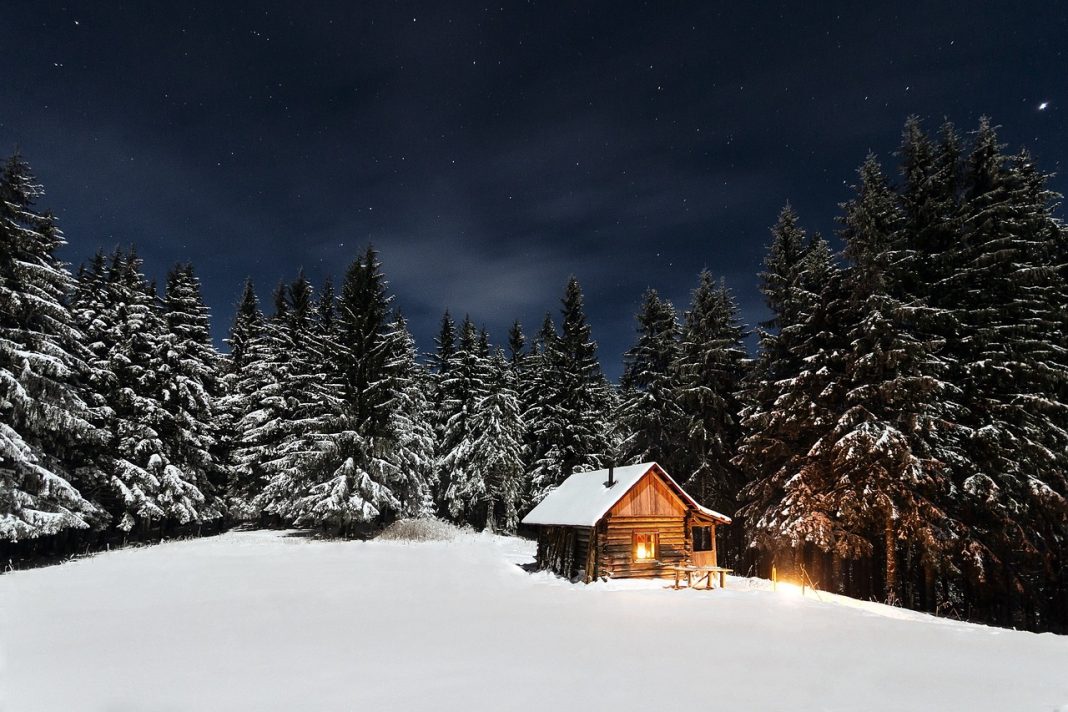 |
|
| Issue #72 • November/December, 2001 |
This is the third part of a three-part series.
The first two parts appeared in issues 70 and 71.
In the last two issues of Backwoods Home Magazine, we carried this series on building your own log home from the beginning planning stage, through actual stacking of logs, to finally roofing that great log home in the peaceful woodsour lifelong dream.
As you read, keep in mind that hundreds of thousands of plain, common folk, often with very little building experience, have built their own log home. Never get discouraged when sarcastic people who only color within the lines put down your dream. You can do it. And when you finish, you’ll have a home that is economical, easy to heat, and nourishing to the soul.
As we left our log home project last issue, we had the roofing material on and the log building looking like a home. But there’s still a lot to do yet. Let’s get started.
Windows
As moisture will warp and discolor wood in your new home, you’ll want to get it dried-in as soon as possible. And, as most “holes” in your new home are window openings, let’s get these in first.
Both my husband and I have some Scotch blood, so perhaps that’s why we hate to pay full price for anything, including windows. Now you can go down to the local window dealer or large building supply and pay upwards onto $1,000 or more for each window, as many people do, or you can be frugal, as my son, Bill, just did, and seek out a builder’s warehouse where “returned” windows end up. These windows are new, ordered for jobs, and were rejected. Perhaps they were the wrong size, the wrong brand, not picked up, had gone out of stock or whatever. But they end up warehoused and sold for very little. Bill bought all the windows for his new log home, including a pretty set of French doors, for less than most folks pay for one large window. Does $50 or $200 each sound like a great deal to you? We thought so, seeing he bought name brands, like Marvin and Pella.
|
Look in large-city phone books for such a warehouse, under windows or building materials. Ask your large building supply dealer and local large contractors where rejected windows go. You’ll have to do some detective work here, but you can find good buys and still use quality windows that will last for years and help energy costs in the bargain. “Cheap” windows are never a good buy. As we don’t always get the exact sizes in these bargain windows, we usually opt to make our window openings smaller than we figure we can find a window to fit. In this way, we have a larger choice of possible selections that will work in a wall. Can’t find a 36 by 60-inch horizontal sliding window? Well, how about this great 38 by 60-inch window? Yep, we can do that. Flexibility saves money and is one reason we only use temporary window framing tacked into the logs as we do the rough building.
Now if you were lucky and had plenty of long logs, you may have a log rectangle with perhaps only a door openingno window openings, at all. Should this be the case, you have the greatest flexibility in choosing your windows and doors. Take a list with your “rough” choices to your bargain window warehouse and shop for what will work for you.
You will not be nailing your pre-hung doors and window framing directly to the logs, nor to a 2×6 or 2×8 frame, which is nailed directly to the logs. This causes logs to hang up during settling which always occurs in log building. You will ALWAYS need to allow for settling, usually about ¾ inch per foot of log wall height. I’ve seen a lot of log homes with cracked window glass, doors that dragged while opening and shutting, windows that would not openor close once openall due to not allowing for settling.
To prevent this type of problem, simply add enough space above each door and window opening to let the logs settle as they will, easily and comfortably. During the interim time, just use a neat trim board and insulation to cover the “hole” above each door and window until the logs have settled.
And, to keep your window and door frames from holding the logs from settling, slot the vertical sides of each opening to receive a 2×4, which itself is slotted at each spike, into each log. As the building settles, the spikes will slide in their slots, letting the logs settle downward without hangup. (Cut each 2×4 short enough to allow ample room at the top for the top log to settle; you don’t want your 2×4 to hold the logs from settling.)
Your door and window frames are screwed or nailed onto these vertical 2x4s and the bottom log, which can be cut in half if necessary, horizontally. The top of the frame “floats” several inches shy of the log above.
Cutting openings
Carefully measure your first window, including space for the frame. Decide where your window should sit on the wall, and with yellow carpenters’ chalk make a mark at the first top corner. Use a level and measure and mark the second top corner. With a plumbline or level, mark the vertical line and measure the two bottom corners. Don’t depend on a log being straight or level. It may or may not be. Remember the builder’s old saying: “Measure twice, cut once.” Once you take a chainsaw to those logs, you can’t “put it back.”
Use a hardhat and safety glasses when cutting these openings. Yep, I know they’re a pain and hot and all of that, but chainsaws can buck back when cutting openings in a log wall, especially if you’re not extremely experienced in operating a saw.
Work the tip of the saw downward into a log, not necessarily the top log. You can later cut upward, more comfortably. Have the saw reved up and the chain moving at maximum speed as you contact the log and, following your chalk line, carefully cut the line downward. If you must, finish your line upward.
Then cut your second line, one log at a time. Remember that these logs are now free and can come tumbling down. It’s best to have a helper behind you to steady the logs. With Swedish coped logs, you may have to “help” them free of the opening with a maul, as the lower edges of each log sit astride the lower log.
If your window opening requires you to cut halfway or less into the top and/or bottom log, this should be done after the rough opening has been cut. You can either chainsaw horizontally, cutting the entire chunk out in one piece (be very careful of kickback here) or you can make several vertical cuts like you did when you make notches, using a hand axe to chip out the chunks.
|
Keep in mind that all lower window framing should have a slight slant downward and outward to drain moisture away from the window and logs. If your factory window does not include this (and it should) slant your frame slightly during construction. Have you used large diameter logs? If you have, you might like to bevel the ends toward the opening, as an artistic touch. I like to do this, as I think it dresses up the whole house. To do this, simply use a lightweight chainsaw and trim three corners off each log butt, angling down toward the opening, slightly. (Practice this on log scraps to get the right technique.)
Now, with your hole cut, again measure your window and trim the hole, if necessary, for a good fit. Then measure and lay up a vertical 2×4 and mark (use a level) for the slot in the log ends. You can cut this slot with the tip of your chainsaw, again using care to guard against kickback. Always begin cutting downward. Several passes are needed, but you will soon get the hang of slot cutting and the work goes quickly. When the 2 by fits nicely in the slot, mark where each spike will go into the center of each log with an X. Then draw a line below each X, allowing ¾ inch for each foot of log wall height. For instance, multiply .75 times 8, if you have an eight-foot log wall, and you will come up with 6 inches of settling allowance. Thus you’ll need a 6-inch slot below each spike to allow those logs to settle nicely.
I lay the 2 bys on the ground, supported by log scraps underneath. Have a helper hold them securely, but safely out of the way. Then, straddling the 2×4, I chainsaw each slot.
When finished, spike each 2 by in its slot, the spike at the top of the slot in the 2×4. Sure it’s a lot of work. But when you do it right, your doors and windows will open and close for decades to come.
Doors
Some of the nicest doors I’ve seen in log homes have been handmade. You can get very artistic if you’ve got the time and inclination, carving wilderness scenes in a simple plank door. Today this is easier than you might think, using one of the handy woodcarving tools, such as a Dremel. This hand-held power tool quickly cuts and chisels designs into wood. Even a novice woodcarver can create wonderful, exquisite doors in a day or two. One fellow I know used a picture in a coloring book as a guide and ended up with two black bears and a moose wandering up his pine-tree studded front door.
With a little imagination, you can create a great compliment to your log home. Don’t want to go “fancy?” A simple plank door, made from half-log siding or plain tongue and groove 2×6 lumber, strengthened on top and bottom with horizontal 1x4s and an X brace of the same lumber in the center does a great job. I made just such a door on the back of our Minnesota homestead many years ago and it’s looking good today.
You will frame your door, as you did your windows, using vertical 2x4s in a slot, slotted to allow for settling. Be sure to allow room at the top for settling, as well.
When using a homebuilt door, be sure to either use a factory hardwood threshold, which is sloped to the outside, or create one of your own. Always slope any openings in the log walls to the outside to direct moisture away from the building.
Of course you can always use factory-built doors for your log home, or choose to build a pretty door for your main entrance, and opt for factory doors for the other doorways.
Insulation
As with any other home, you need to insulate any non-log outside walls and the roof. Although expensive, fiberglass insulation is usually the best bet. Rodents will not chew it to pieces and it is quite easy to apply. Without insulation, the energy expended for home heating and cooling will be astronomical. One uninsulated log home I lived in required 14 cords of hardwood to heat during a winter. When the roof and gables were insulated, the winter wood needed dropped to 7 cords and the home was much warmer.
Please don’t use alternative insulation, such as straw, cardboard, or sawdust. Not only will these be a great fire danger, they are less effective insulators and they attract rodents. Better to use no insulation and wait until you can afford rolled fiberglass.
Pressure washing logs
As log building often takes a good deal of time, from several months to a few years, logs change color from the time they are peeled to the time you are ready to put a sealing stain on them. And not only do they usually grey, but often surface mold and mildew builds on the surface of the logs, making them quite unattractive. There is a quick and cheap method of renewing the logs’ beauty, however. Rent a pressure washer.
Not only will the pressure washer remove greying and mold stains, but it will remove dirt and marks, stray bits of inner bark, carpenter’s chalk marks, and foot tracks. (People who walk on those gorgeous logs while you’re building seldom do so with clean booties.)
A solution of mild detergent and plain chlorine bleach is all you need to do a great job. Go light on the bleach; half a cup per gallon of water is enough.
Mix your solution and begin spraying. Start on the back top of your house and you’ll soon get the hang of it. Don’t stop and concentrate too heavily on one area or you may cause damage to the fiber in the log. If a spot doesn’t come clean, use a brush and stronger solution.
Do one wall completely, top to bottom, then rinse it well. Then move on to another wall. If you do the whole house, waiting until you finish to rinse, the solution will soak into the logs and dry, making rinsing difficult.
|
Most homes are not large enough to make pressure washing an option inside plus the flooring would be damaged by that much water soaking in. A good midground here is to use a bucket of detergent/bleach solution and a scrub brush. As the interior logs are usually a whole lot less grey and stained, they clean up in a jiffy. But be sure to rinse well. I use a mop and clear water to rinse, and old towels to dry things (and me) up a bit.
After pressure washing, it’s a good idea to examine your logs for rough knots, saw marks, and deep scratches. These can easily and quickly be touched up with a disc sander and hand sanding to finish the surfaces.
Should your log home’s logs still have ragged, uneven ends sticking out far past your notches, this is the time to cut them even, about 18 inches past the notch. If you cut closer, you have no option to trim weathering ends in, say, 40 years. Okay, so your kids may be the ones to trim the ends; the point is that your home will have the option, unavailable if you trim your ends too close to the notch.
Some log builders add artistic touches to their log ends, beveling the ends all around, leaving the upper logs longer and cutting a curve down to the mid height and so on. Let your artistic spirit fly. One method I don’t like, structurally, is cutting a curve which leaves the lower log ends longer with much exposed cut surface available to the weather. This is rotting, waiting to happen.
Staining and sealing
Give your logs a few days to thoroughly dry and you will be ready to put a sealer on your logs to protect them and prevent them from discoloring in the future. Yes, you can just let nature take its course, but your logs will last a whole lot longer and remain beautiful if you use a sealant.
Use a true log sealant, not just your run-of-the-mill stain you got from the lumber yard. It does cost more, but you’ll get much more protection for your buck. And even the best sealants can “wear out” due to weathering and sunlight. You need to check the logs, especially on the south side every few years, recoating when necessary.
You can choose from dozens of colors and shades of sealant, from clear to very dark, all of which will protect your hard-earned log home from the savage teeth of the weather. The choice of color is totally a personal one; some like a very light beige and others, me included, prefer a dark (pine bark in the shade) log.
Sealant can either be brushed on by hand or sprayed, according to product directions. If you choose to spray, you’ll have to mask the windows (or spray before installing them) and rent a quality sprayer if you or your friends don’t already have one. A cheap sprayer produces shabby results.
Many log builders use two coats of sealant on raw logs, one which soaks in and another, often, just for added protection. I would personally recommend this because planning on giving a second coat next year often results in never getting around to it.
Porches
I think the perfect log home is incomplete unless it has at least one porch. Not only is a porch soul-satisfying to look at, but it’s darned nice to sit on before work begins in the morning or when we’re tired in the evening. We often spend hours after dark on the porch just looking at the stars. You find more peace there than anyone does “relaxing” in front of the boob tube.
And a porch is useful, too. It’s a place to kick off muddy boots, out of the weather, a place to store a couple of day’s wood, all nice and dry. It gives a place for the dogs to go under to get out of the sun or rain, and it makes a great place to eat frequent meals. Company can even bunk out on the porch and keep the dew off their blankets. (Folks beg to sleep on our porch, just so they can watch the stars and mountains.)
A porch is easily added while building your log home. I like to get the house dried in, then work on it. But you can build the porch on as you work on the house if it suits you.
To get started, simply measure out from your house wall, eight or ten feet (a porch can be narrower, but you’ll soon wish it were wider) and dig a hole for an 8-inch sonotube (the heavy cardboard tubes we used in the house footings), one out from each corner and one every 8 feet or so across the porch.
|
I dig down two feet in solid soil, more in looser soil, slide a sonotube in with rebar extending almost to the point I figure on cutting the tube off where the top will be level with my needs. Then make the first pour of cement.
The next day the concrete will have set up enough to cut the tubes. With a chalkline, mark a level line across all tubes about eight inches up from ground level. Then mark another level line on the side of each tube. This will help you cut the tubes off straight and level. Cut the tubes carefully with a chainsaw. Then embed a ¾-inch anchor bolt in each tube, to be left with six inches sticking out above the concrete. (These will hold the porch posts in place.) Wet yesterday’s concrete if it has dried, then make a second careful pour and level each tube top and anchor bolt.
Most of the “big-guy” log home builders place adjustment screws under each porch post in lieu of the anchor bolts we use. But they usually are building huge homes and in only several weeks. We backwoods folk usually take over two years to get around to the porch and the logs in the home have settled just about all they will.
While the concrete is curing, prepare your porch posts, cutting them to length, peeling them, assembling 2x10s which will support the lower end of the porch rafters, and cutting and peeling porch rafters. (Remember to allow for the roof pitch and at least a three foot overhang when cutting those rafters.) I usually cut them a little long and trim them on the building for a perfect result.
The porch rafters should be poles of at least 4-inch diameter on the small end to be serviceable and match the house well. Dimension lumber can be used, of course, but it will never look as nice.
Each porch post is drilled, on center, to receive the anchor bolt in the footing concrete, then it is lifted and carefully set in place. For safety’s sake, it’s a good idea to nail a brace from the top of the post to the ground to keep the posts in place until the rest of the porch framing is finished.
If your home is relatively low, you will probably have to rest the upper end of your porch rafters up on the house roof, two or three feet up from the eaves. Be sure to center each rafter on a house rafter for a secure joint. (If this is the case, you will need to make allowances for the porch when roofing this side of the house, especially if you’re using sheet metal roofing.)
A taller log house can have the porch rafters spiked onto a log on the front of the house below the roof. Also rest the high end of the rafters on a 2×6 spiked onto the log below them. Many log builders notch into the house logs to receive the upper end of the porch rafters. This makes a strong, very attractive joinery system.
When all posts are in place, hopefully with a helper or two, spike the 2×10 across the front of the porch, making sure it’s level. In areas with a heavy snow load, notch the upright porch posts to receive the 2×10. In other areas, it is acceptable to simply spike the 2 by onto the posts keeping everything square and level. It’s generally adequate to space the rafters every two feet along the porch roof.
Then, having a bevel cut on the upper end of your porch rafters and a gentle notch on the lower end to fit over the 2×10, spike the first rafter in place. Do the opposite end of the porch next, taking great care to get everything square and level. Finish spiking in your rafters and your porch is beginning to look like a porch.
|
With a larger home it is a good idea to add a horizontal brace on each end of the porch, being notched and spiked into the log wall and the corner porch post. This prevents any twisting of the porch, due to wind or snow weight.
Your actual roofing can be rough sawn lumber from your own woods for a more rustic (yet serviceable) look or tongue and groove 2×6 finished lumber. Take care to knock off any knots on the upper surface of your rafters so your roof lays down nice and level. Any dips may be shimmed up with wood wedges.
Sheet the roof with tar paper, then cover with roofing that matches your new home. Pretty nice, huh?
Now for that sitting surface. Notch-in and nail your perimeter floor beams to the posts. Then simply deck the porch floor as you would a deck, using either treated deck lumber or homegrown 2-inch planed lumber, spaced ½ inch apart for drainage and given a good double coating of deck sealant. As with your logs, your porch can be nearly any color you desire. One handy hint: use deck screws, not nails. The nails will work loose over time, and you’ll be sorry you didn’t take the little extra time and expense necessary to do it right.
One more thing and you’ve got a porch. You need a couple of good rocking chairs or a porch swing. This is a must. Only out in the boonies does one get the full pleasure a porch is meant to give. I promise. Togetherness is fulfilled on a porchfamily, friends and neighbors.
Half-log stairway into the loft or second floor
If your log home has a loft or second story, you’re going to have to get up there, right. Now you could simply build a ladder out of poles or nail up a traditional stairway made out of dimension lumber. But if you’ve gone to all the trouble of building a very personal log home, why not pull out all the stops and put together a great half-log stairway? I’m no carpenter, but I can whack out a pretty neat half-log stairway in two days’ time. And if I can, you can.
I know there are a lot of mathematical formulas out there for getting stairways right. But I never paid much attention to math. So I find a pretty log I like, at least 10 inches in diameter, and rough bevel the top end to fit the upper wall, where the stairs should be. Then I make rough adjustments to the log to get it to fit where I decide I want it. When done, your log should fit nicely from floor to a sturdy header or floor joist of the upper floor.
Now is the time to decide whether you want to use two matching log stringers for your stairway or simply cut this log in half. If you have plenty of room, I’d suggest using two full logs, as it looks great and is very sturdy.
Tack your stringer log (don’t cut it yet) into place, where it will go, then decide where your stair treads will need to go. Stop here and walk up and down several sets of stairs. Everyone is different in their stride, in their balance. Find a set that feels right to you and your family and make a note of the distance between steps and the angle of the stringer. Too steep a stairway and it is not only dangerous but very uncomfortable to walk daily.
|
Now measure where the tops of each of your intended steps will be and make a carpenter’s chalk mark, level.
You will be cutting “C” shaped notches in the log stringer to receive half-log steps. The flat surface of the half-log will be the step.
Now choose a few mid-diameter logs for this purpose. I prefer to use fairly large logs, say a 12-incher, as by sawing it in half I still have a 6-inch thick, 12-inch wide step. The wider the stairway is, the better, in my book, constrained only by your available space in the room. Realistically, your stairway will probably end up three feet wide; I like a 6-inch overhang for artistic purposes, in addition.
By sawing a small slice off your first stair-step log, you can position it below each of your chalk marks and draw around it with your chalk. This will be your “C” shaped notch to receive the step.
In a few minutes, you can fully mark your log stringer. If you plan on using two full log stringers, lay your second stringer next to this one and carefully mark it exactly the same as the first. Then, using the same notching process you used on your log home notches, making many cuts almost down to your mark with a chainsaw, then trimming out the excess, cut all the notches in both stringers. Use a chisel to “fine tune” your notches to perfection.
If you are planning on using half-log stringers, simply notch out your one log stringer, then snap a chalkline down the center of the stringer and very carefully saw down the center, cleaving the log in half. (Be extra careful to run the saw smoothly on the faces of the notches or the narrow lip may chip off. But by now you should be able to cut a dress pattern out of a tree. And if you screw up, there’s always more trees in the woods. Use your ruined stringer as a pattern, then make a short log stairway out the back door or down off the porch. Waste not, want not.)
Then, in a like manner, cut enough stair logs in half to make your stairway. Then spike the puppy together. By pre-drilling holes with a slightly smaller drill bit, you won’t split any half-logs.
I’ve used smooth, drawknifed poles for a rustic yet beautiful railing, and lighter poles for balusters, whittled to fit tight into holes bored in top and bottom rail. Just like in those expensive log home magazines. Only with the innate satisfaction of having done it ourselves. It’s what backwoods living is all about. Welcome home!




















